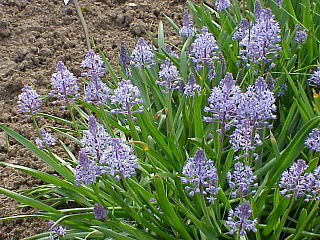
Scilla is a genus of about 50 to 80 bulb-forming perennial herbs in the family Asparagaceae, subfamily Scilloideae, native to woodlands, subalpine meadows, and seashores throughout Europe, Africa and the Middle-East. A few species are also naturalized in Australia, New Zealand and North America. Their flowers are usually blue, but white, pink, and purple types are known; most flower in early spring, but a few are autumn-flowering. Several Scilla species are valued as ornamental garden plants.

Scilla siberica is a species of flowering plant in the family Asparagaceae, native to southwestern Russia, the Caucasus, and Turkey. Despite its name, it is not native to Siberia.

Scilla peruviana, the Portuguese squill, is a species of Scilla native to the western Mediterranean region in Iberia, Italy, and northwest Africa.

Hyacinthoides italica, the Italian bluebell or Italian squill, is a spring-flowering bulbous perennial plant belonging to the family Asparagaceae.

Scilla verna, commonly known as spring squill, is a flowering plant native to Western Europe. It belongs to the squill genus Scilla. Its star-like blue flowers are produced during the spring.
NVC community H7 is one of the heath communities in the British National Vegetation Classification system. It is one of two communities categorised as maritime heaths.

Scilla section Chionodoxa, known as glory-of-the-snow, is a small group of bulbous perennial flowering plants in the family Asparagaceae, subfamily Scilloideae. Formerly treated as the separate genus Chionodoxa, they are now included in Scilla as a section. The section is endemic to the eastern Mediterranean, specifically Crete, Cyprus and Turkey. The blue, white or pink flowers appear early in the year making them valuable garden ornamentals. The common name of the group is based on the habit of flowering in high alpine zones when the snow melts in spring.

Drimia maritima is a species of flowering plant in the family Asparagaceae, subfamily Scilloideae. This species is known by several common names, including squill, sea squill, sea onion, and maritime squill. It may also be called red squill, particularly a form which produces red-tinged flowers instead of white. It is native to southern Europe, western Asia, and northern Africa.
Scilla morrisii is a critically endangered species of plant in the family Hyacinthaceae. It is endemic to Mediterranean-type shrubby vegetation on the island of Cyprus.

Chamaescilla is a genus of Australian herbs in the Lomandra subfamily within the asparagus family, They have grass-like basal leaves and tuberous roots. The flowers have 6 petals and 6 stamens. The seed capsules contain black, glossy seeds.

Scilliroside is a toxic compound derived from the plant Drimia maritima, which is sometimes used as a rodenticide.

Chamaescilla corymbosa, commonly known as blue stars, blue squill or mudrurt, is a tuberous perennial herb species in the genus Chamaescilla. It is endemic to southern Australia.

Prospero autumnale, the autumn squill, an autumnal flowering plant of the family Asparagaceae, subfamily Scilloideae, is found in the Mediterranean region from Portugal and Morocco east to Turkey and the Caucasus, plus Great Britain. Despite being classified as a single species, it is actually a cryptic species complex, with a variety of cytotypes having been discovered which are phenotypically indisguishable from each other.

Scilla mischtschenkoana is a perennial that is native to the South Caucasus and northern Iran.

Scilla bifolia is a herbaceous perennial growing from an underground bulb, belonging to the genus Scilla of the family Asparagaceae.

Muscari aucheri, Aucher-Eloy grape hyacinth, is a species of flowering plant in the squill subfamily Scilloideae of the asparagus family Asparagaceae. It is a perennial bulbous plant, one of a number of species and genera known as grape hyacinths. Originally from Turkey, where it grows in grassy alpine areas, it is sometimes grown as an ornamental plant. The synonym M. tubergenianum may be found in the horticultural literature.

Scilla litardierei, the amethyst meadow squill or Dalmatian scilla, is a species of flowering plant in the family Asparagaceae. A bulbous perennial, it is grown for its blue grape-hyacinth like flowers, blooming in late spring, much later than the more popular Siberian squill and later than Muscari which it resembles. Originating in the western Balkans, it was introduced to western Europe (England) in 1827. It has become much more easily available since 2004.

Ledebouria revoluta, the south Indian squill, is a flowering plant species in the genus Ledebouria found in Southern Africa and India.

Puschkinia scilloides, commonly known as striped squill or Lebanon squill, is a bulbous perennial, native to Western Asia and the Caucasus.

Pseudomuscari chalusicum, the Chalus grape hyacinth, is a species of flowering plant in the squill subfamily Scilloideae of the asparagus family Asparagaceae, native to Iran. Chalus is a county in northern Iran. Growing to about 15 cm (5.9 in) in height, it is a bulbous perennial with floppy, curved leaves sitting close to the ground, and small clusters of bell-shaped flowers on erect stems, appearing in mid-spring. The flower colour is pale blue at the tip, shading downwards to a darker blue. Unlike some other Muscari species, it does not spread rapidly.
















